Iran Unveils New Missile, Drone Amid Growing Concerns
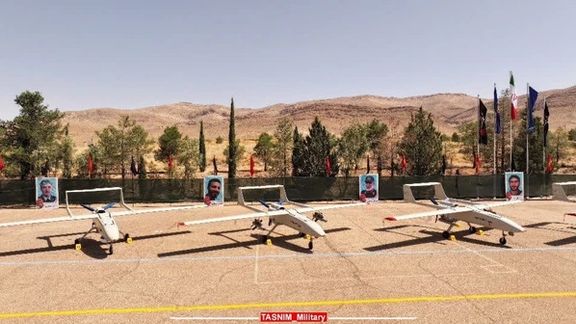
The Islamic Revolutionary Guard Corps Navy unveiled new systems and weapons systems such as missiles, drones, and electronic warfare during a ceremony on Saturday.

The Islamic Revolutionary Guard Corps Navy unveiled new systems and weapons systems such as missiles, drones, and electronic warfare during a ceremony on Saturday.
Amid rising concerns about Iran's military activities, the IRGC showcased various types of reconnaissance, intelligence, offensive, and combat drones, support and command vehicles, as well as offense and defense systems in the electronic war domain.
According to Tasnim news agency, among the systems were a variety of cruise missile launch trucks, radar and command systems, and hundreds of cruise and ballistic missiles with ranges of 300 to 1000 kilometers.
During the ceremony, the IRGC Commander, Hossein Salami, claimed the IRGC is getting more powerful, even amidst international sanctions and pressure. He alleged that its strength has surpassed the enemy's ability to control or confront Iran's military.
Salami stated, "With a history of standing in the face of threats and dangers for decades, we have found a way to become powerful; in fact, the enemy has been the cause of our growth."
The IRGC was established shortly after the 1979 Islamic Revolution with the primary objective of protecting the Shi'ite clerical ruling system, but has become instrumental in Tehran regional interventions.
The US designated the IRGC as a terrorist organization in April 2019 due to charges of global terror acts, violations of armed conflict laws, assassination attempts, and support for regional terrorist groups. The European Parliament supported designating the IRGC as a terrorist group in January. However, the EU says it cannot do so until a court confirms the classification.
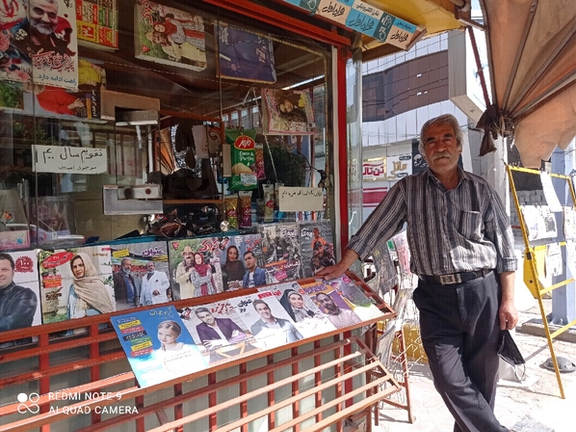
Journalists in Iran say their salaries are not enough for their living expenses, and even if they are paid on time, it only covers basic expenses for half of the month.
Iran international conducted interviews with more than 20 journalists in various cities who work for newspapers or news agencies.
According to the interviewees, the average salaries of journalists in provinces like Esfahan, Khorasan Razavi, Gilan, West Azerbaijan and Sistan-Baluchistan range from 40 to 60 million rials ($80-120) a month.
This means that journalists get paid less than the minimum wage, which the government this year increased to above 70 million rials ($140).
A Journalist in Khorasan Razavi province in northeast, emphasizing the living difficulties for journalists said, "Salaries in some Telegram channels like Akbar Mashhad start from 7 million rials ($14) and may reach 4 million ($80) a month, like other journalist in our province. Of course, editors may receive between 100 and 120 million rials ($200-220)."
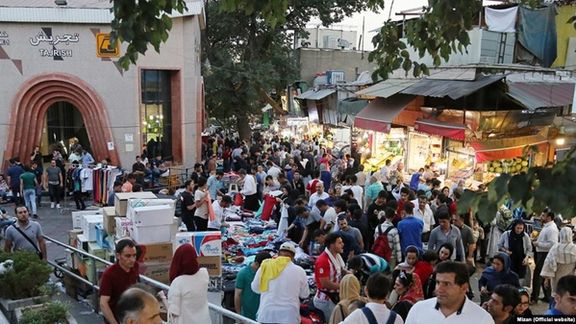
According to a report by the Parliamentary Research Centre published this month the number of Iranian below the poverty line increased from 19 percent to over 30 percent in the past decade. In fact, more than 30 percent of Iran's populations lives below the poverty line. Some experts say that nearly half the population is now below the poverty line, which is defined as having an income of less than around $200 a month. Many journalists are also among the people living below the poverty line.
Journalists in Esfahan emphasized that their salaries have been paid with delays in the past year, and in some cases, they have been divided into instalments. They said, "A salary of 5.3 million rials ($105) is practically meaningless considering rising inflation and the high cost of living. There is no institution or syndicate to file a complaint with, and any protest is met with reprimands and dismissals."
Although the government claims annual inflation is at 40 percent, economists and some lawmakers believe it is closer to 70 percent. Food price inflation is estimated to be between 70-120 percent since May 2022.
A reporter from one of the news agencies in Tehran also said: "On paper, I receive around 80 million rials ($160) as my monthly salary, but due to various deductions, I end up with something close to 77 million. It's clear that with such a salary, it's impossible to live in Tehran. Depending on my shift, I do some extra work before or after my job as a driver. Once, I gave a ride to someone I had interviewed weeks earlier. The person was shocked that I was driving a taxi and repeatedly asked if I wanted to write an article about why I had to do a second job."
A reporter from one of the newspapers in Tehran told us, "I had left my parents’ home and lived alone, but my financial situation became so difficult that I had to return and live with them, however, not everyone has this option. We are barely making ends meet. I made around 100 million rials a month, but still, my income and expenses did not balance out."
Increasing censorship
The economic problem is not the only challenge facing journalists in Iran. They are daily confronted with various newly imposed restrictions. One journalist spoke about the pressures and new limitations, saying, "Reporting has become like the fluctuating dollar rate, they keep setting momentary red lines for us."
He added: "It is possible that yesterday an agreed upon report was allowed to be published, but the next day, the editors and chief editors, or the managing director say that the report should not be printed. To make our conscience suffer even more, they say, 'Are you willing to take the responsibility for others losing their jobs [if the news outlet is shut down]?’ “
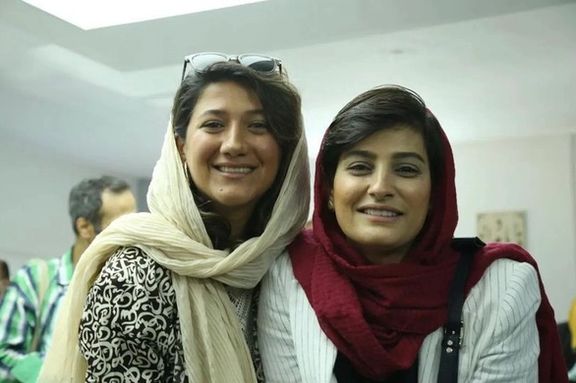
During months of anti-government protests that began last September, dozens of journalists were detained, some simply for a tweet or as a preventive measure. Two reporters who broke the news about Mahsa Amini, whose death in the custody of hijab police sparked the protests, are still in jail.
A reporter from one of the news agencies in Tehran stated: "Limitations on writing news depending on the country's situation have always existed. For example, we were not allowed to cover the Haft Tappeh workers' strike for a while, and later the choice of words was completely controlled. But during the protests since September 2022, these limitations have doubled."
This reporter went on to say, "After being shocked by the killing of Kian [a 10-year-old boy shot by security forces during protests], I posted a story on my personal page. In less than 24 hours, I received a call from an unknown number, and in a harsh tone, they told me to delete the story and warned that if it happened again, they would fire me from the newspaper."
Another journalist who was recently interrogated by security forces described the dangers inherent in censorship. "We used to know what words to use and what words were prohibited, or at least we followed the criteria according to directives from the Supreme National Security Council. But after the killing of Mahsa, the conditions drastically changed, and they began to apply all sorts of pressures to restrict independent journalists. They us no to do our professional work effectively, but…we take pride in our profession and stand with the people as long as we can."

Narges Mohammadi, a prominent imprisoned Iranian human rights activist has been handed down an additional one year jail sentence in a new verdict.
This latest decision by the judiciary of the Islamic Republic has increased her total sentence to 10 years and 9 months in prison, coupled with 154 lashes.
The verdict stems from Mohammadi's alleged offense of "propaganda against the system by giving a statement from inside the prison," as stated on her Instagram page. In the said statement, she voiced her protest against the "harassment and sexual abuse of women" in detention centers, and addressed a letter to Javaid Rehman, the Special Rapporteur on the Situation of Human Rights in the Islamic Republic of Iran.
This particular case is one of the five ongoing investigations against Narges Mohammadi, conducted by the Evin Security Prosecutor's Office.
Refusing to participate in the hearing of the new accusations, Mohammadi, the Deputy Director of the Defenders of Human Rights Centre (DHRC), boldly declared that she "does not recognize the Islamic Republic and its sham and deceptive courts," as conveyed in her Instagram post.
The preliminary verdict was communicated to Mohammadi while she remains detained in the women's ward of Evin prison. However, she did not sign the receipt of the verdict.
In recent months, despite her confinement, Mohammadi has been an outspoken advocate for the uprising of Iranians against the Islamic Republic. From inside the prison, she has openly condemned repression against protesting students, citizens, and the Baha'i community, among others.
Narges Mohammadi's imprisonment dates back to November 2021, and she continues to serve her sentence.

Iran unveiled a series of what it called new maritime weapons this week as Washington appeared to be increasing pressure on Tehran on at least two fronts.
In its boldest move to deter Iran since assuming office, the Biden administration signaled on Wednesday that it may soon offer to put armed sailors and Marines on commercial ships traveling through the Strait of Hormuz.
The Pentagon last month had already sent additional F-35 and F-16 fighter jets along with a warship to the Middle East in a bid to monitor key waterways in the region following Iran's seizure and harassment of commercial vessels.
The Islamic Revolutionary Guard (IRGC) held drills around three Iranian islands in the Persian Gulf contested by the United Arab Emirates and claimed that it has added a 600-kilometer-range new missile to its arsenal “for defending the islands’ territory.”
Hossein Salami the commander of the IRGC delivered another speech on Saturday, praising what he called unprecedented advances the Islamic Republic ha made in naval power. In typical veiled language Salami said that “the enemy’s presence instead of posing a threat became an opportunity…and we expanded our defense and military” capabilities.
Salami also stated that Iran has been able to de-couple “the enemy’s military power” from its psychological dimension, implying that Tehran is not afraid of the overwhelming power wielded by the United States.
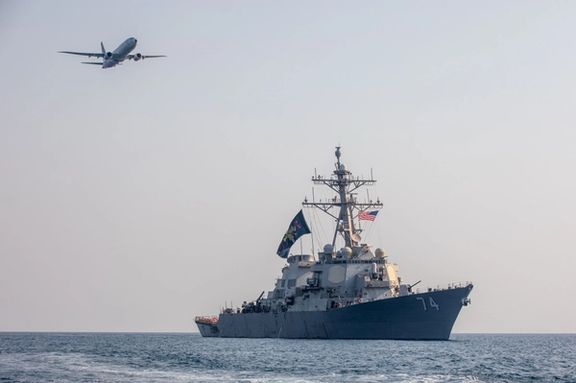
By offering to protect commercial vessels, the United States may be trying to prevent what it anticipates as inevitable Iranian escalation amid a lack of an agreement on Iran’s nuclear program and continuing US sanctions that have led to a hopeless economic situation for Tehran. But the show of force could also be apart of Washington’s efforts to re-engage in the Middle East to show Saudi Arabia and its allies in the Persian Gulf that it is the ultimate guarantor of security.
Vice Admiral Brad Cooper met met with Gulf Cooperation Council Secretary General, Jasem Mohamed Al Budaiwi, in Riyadh to discuss “maritime collaboration for ensuring the free flow of global commerce in & near critical regional waterways,” US Naval Forces Central Command announced Thursday.
Already, the US Navy is authorized to defend vessels belonging to countries with whom there is a mutual defense agreement, including Saudi Arabia and its Persian Gulf allies. However, Al-Monitor cited US officials as saying that the Pentagon has been discussing options with the National Security Council to expand maritime commercial defense “potentially including ownership of the ship or its cargo.”
As the Biden administration appears to be adopting a more forceful posture in the Persian Gulf, it is also ramping up pressure on Tehran over the issue of Iranian drone supplies to Russia.
NBC news reported Friday that the Defense Intelligence Agency (DIA) has decided to show foreign officials “undeniable” evidence of the Iranian origin of drones shout down over Ukraine.
Washington first warned about Tehran’s plan to supply attack drones to Russia in July 2022 and in October it announced that indeed Moscow had started to use Shahed kamikaze drones against Ukraine. In February the DIA issued a report saying that analysis confirmed Russia’s use of various lethal Iranian unmanned aerial vehicles (UAVs) against Ukraine.
Iran has retaliated in recent days by calling for a halt to Western arms supplies for Ukraine blaming the assistance for prolonging the war.
Iran has long been an ally of Russia both in the Syrian civil war and during the invasion of Ukraine despite its claims of neutrality. The government media in Tehran has displayed clear support for Russia and officials have never condemned Moscow's attacks on civilians. So far, Russia has used hundreds of Iranian-made drones against Ukrainian civilian and infrastructure targets.
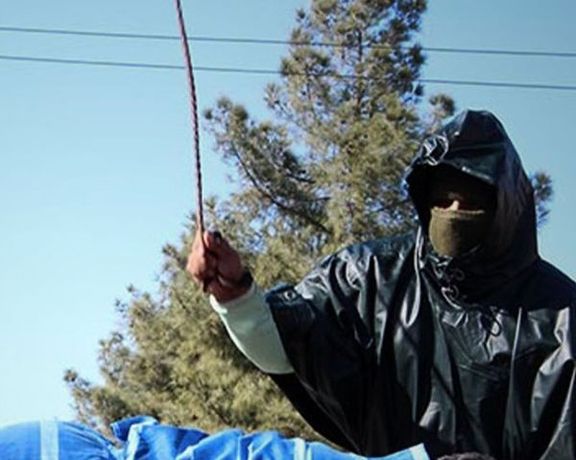
Iran's judiciary has dramatically increased lashing sentences against civil and political activists following the Mahsa uprising, according to Iran's Prison's Atlas.
The issuance of such sentences, part of the Islamic penal code, has quadrupled compared to the previous year, with at least 117 activists, including 13 women and 104 men, being sentenced to a total of 7,404 lashes, alongside 99 years and three months in prison and a fine of 1.16 billion rials (approximately $2300).
The charges leading to these sentences primarily involve "disturbing public order and publishing falsehoods with the intention of disturbing the public opinion," as per the Islamic Penal Code.
Comparing the current statistics to the period from September 2021 to October 2022, the judicial system had sentenced 29 political and civil activists, comprising 18 women and 11 men, to a total of 1,970 lashes, 32 years and 10 months in prison, and 510 million rials in fines.
The Atlas of Iranian Prisons strongly criticized the authorities for employing whipping, despite being aware of its physical and psychological harm, to suppress citizens and political opponents and maintain ideological control.
The increase in flogging sentences coincides with ongoing concerns about the treatment of protesters following the revolutionary uprising of Women, Life, Freedom. Many arrested protesters currently face the risk of execution, and the judicial system has already carried out death sentences against seven of them.
Disturbingly, numerous reports have emerged detailing incidents of rape, assault, and sexual harassment against some arrested protesters during the uprising. Moreover, several other detainees have suspiciously died shortly after their release from prison.

Abu Dhabi National Oil Company (ADNOC) is set to acquire a 30-percent equity stake in the Absheron gas and condensate field in the Caspian Sea.
According to the ADNOC on Friday, the agreement would see Azerbaijan's state oil company SOCAR and TotalEnergies, which had each previously held a 50-percent stake, both retaining a 35-percent share in the maritime field off the coast of Baku, Azerbaijan.
TotalEnergies announced the first gas delivery from Absheron in July. The French energy group confirmed on Friday it and SOCAR had each sold a 15-percent interest in the field to ADNOC, without specifying the price.
The venture opens up opportunities for ADNOC to expand significantly in the Caspian region with rich energy resources and substantial growth potential, providing access to promising international gas markets in Europe and Central Asia.
Following Russia's invasion of Ukraine in February 2022, the ADNOC has sharpened its focus on the gas market as competition for LNG has ramped up with Europe needing large amounts to help replace Russian gas. ADNOC listed its gas business in March after raising $2.5 billion from an initial public offering (IPO), which was the world's biggest in the first quarter of 2023.

While the Islamic Republic is using the Caspian Sea as a route to move drones, ammunition, and mortar shells to Russia for use in Ukraine, other countries are vying for the huge European energy market.
Iran is also cooperating with Russia in the Chalous gas field in the Caspian Sea, with the potentially lucrative field being at the center of discussions over an Iran-Russia 20-year strategic deal. In June 2021, Iran’s Khazar Exploration and Production Company (Kepco), then touted as the field’s main developer, suggested the field held 30 percent of the developable natural gas reserves of all Caspian Sea littoral counties and could potentially meet 20 percent of all European demand for gas. According to Simon Watkins of Oilprice.com in November 2021, further studies have revealed that the field has far more reserves than previously thought, with a total 7.1 trillion cubic meters, about half the reserves of South Pars, Iran’s huge field in the Persian Gulf.
The Caspian Sea was a Russo-Iranian shared water until 1991. Following the collapse of the Soviet Union, Kazakhstan, Azerbaijan, and Turkmenistan claimed a minimum 20-percent share of the sea. Tehran – along with Moscow – were the main losers of territory in the new demarcation of boundaries and prefer he Soviet-Iranian settlement to be valid in the post-Soviet era.
For almost three decades, the five littoral countries have argued over how to divide the world’s biggest enclosed body of water. The Convention on the legal status of the Caspian Sea -- a treaty signed in Aktau, Kazakhstan, in 2018 by the Islamic Republic of Iran, Russia, Kazakhstan, Azerbaijan, and Turkmenistan – significantly reduced Iran’s rights. Iran only controls 680 kilometers or, in other words, 10 percent of the 7,000-kilometer coastline of the Caspian Sea. Due to the presence of numerous oil fields on the seabed of the Caspian Sea the question of legal status is also very important, so the delimitation of the seabed is yet to be agreed on between littoral nations, Iranian President Hassan Rouhani said after signing the agreement.

Nicolas Terraz, the president of exploration and production at TotalEnergies, welcomed ADNOC as one of the strategic partners to the project, saying the Absheron gas field “offers a significant further development potential to meet the growing gas demand.”
ADNOC's investment in Azerbaijan is in line with the UAE’s aspirations to grow its international gas business portfolio, a strategic plan that saw the oil giant offering with BP to jointly acquire 50% of Israeli offshore natural gas producer NewMed Energy. The $2-billion offer marked Abu Dhabi’s state oil company entering Israel's growing energy sector.